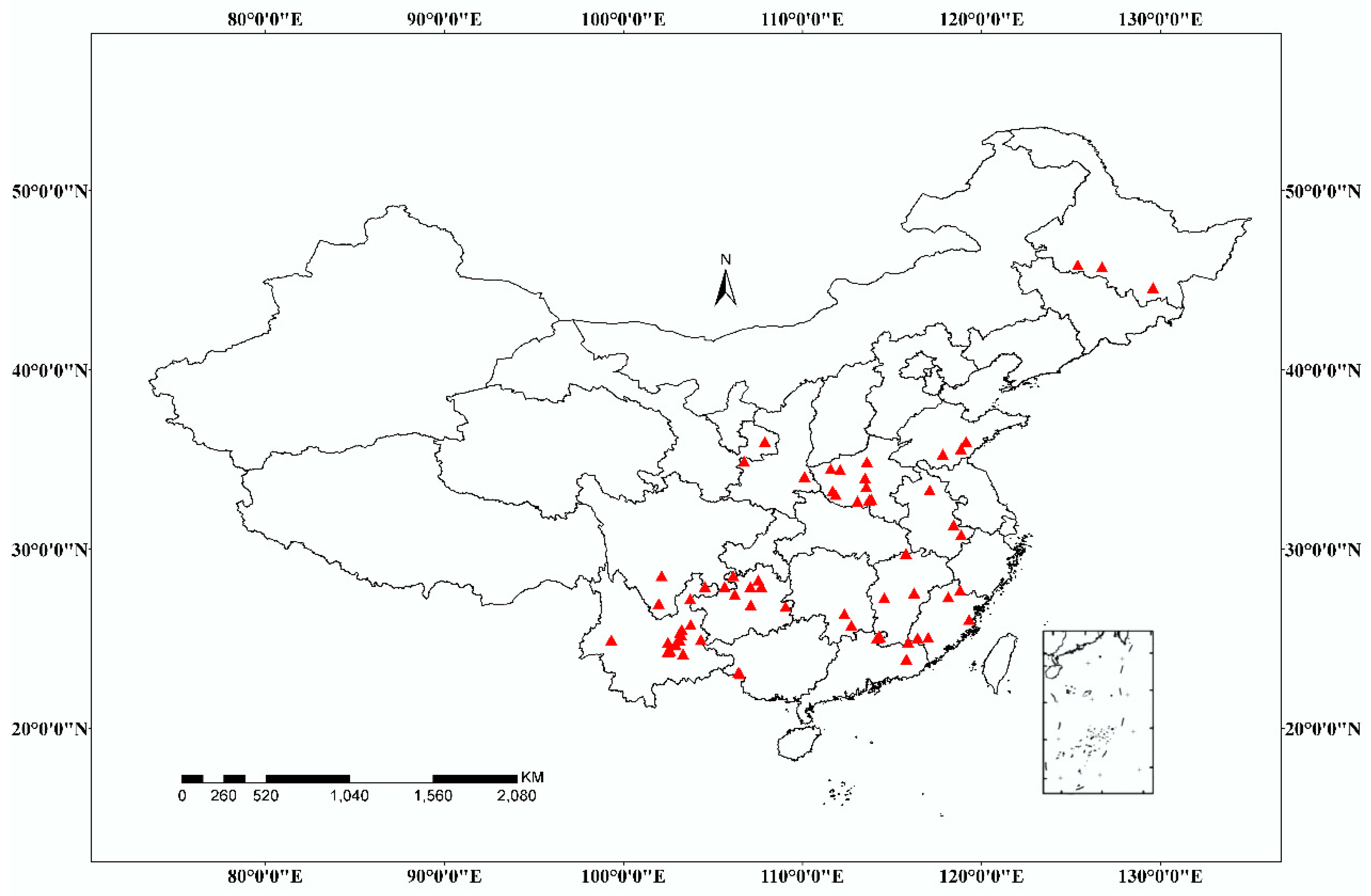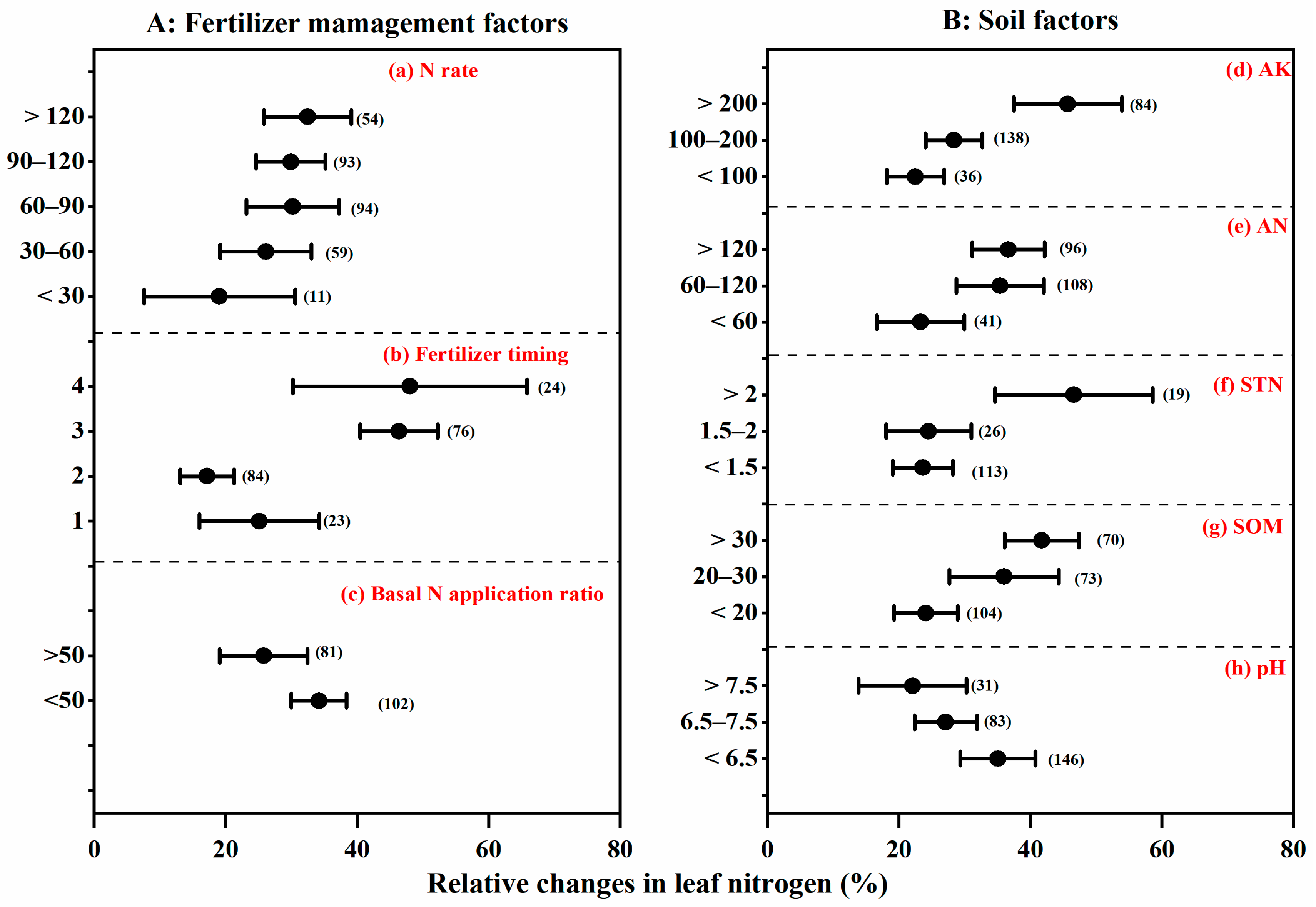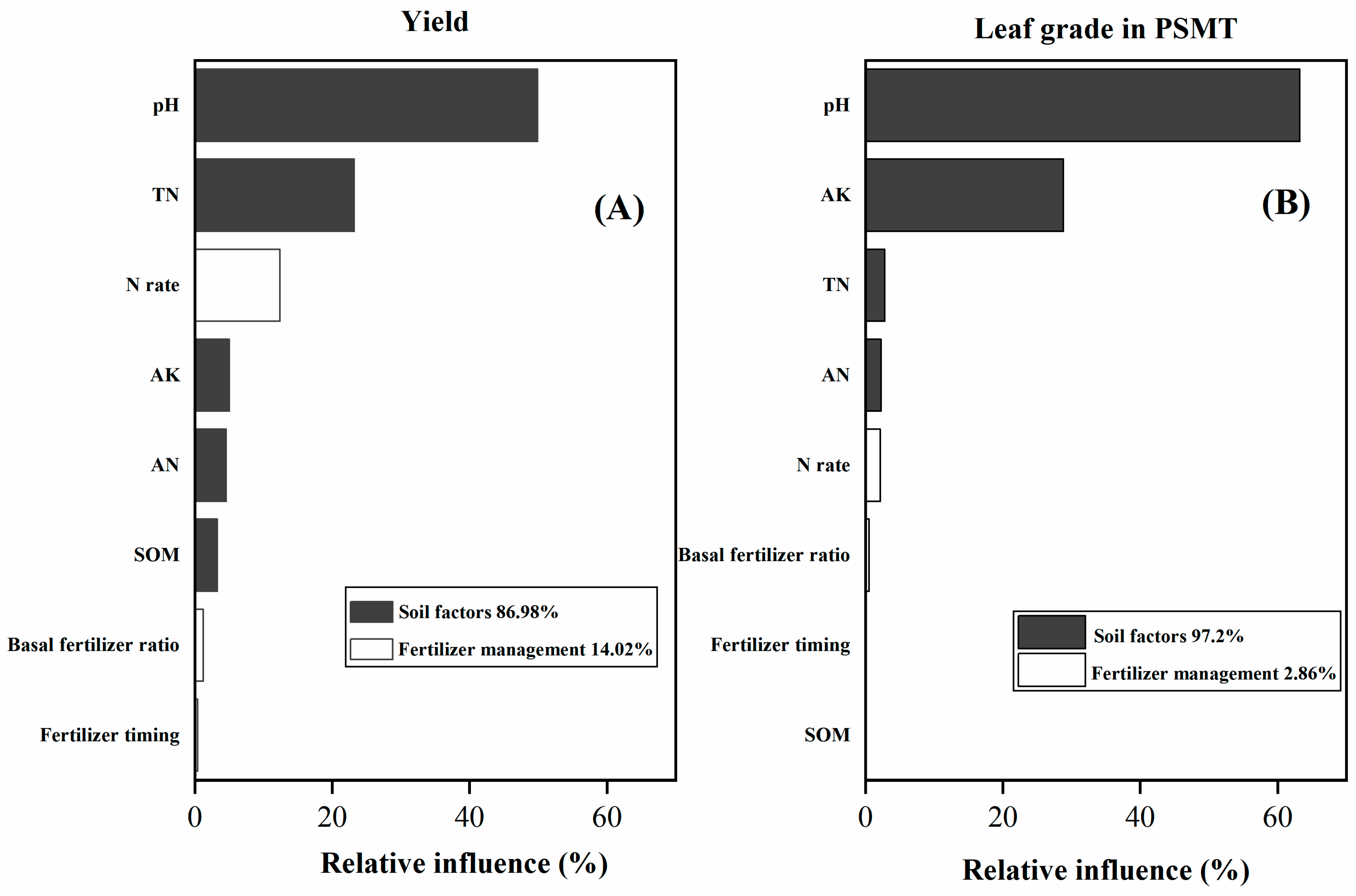Exploring the Effects of Nitrogen Fertilization Management and Soil Factors on the Yield and Quality of Flue-Cured Tobacco in China—A Quantitative Research
Abstract
1. Introduction
2. Material and Methods
2.1. Data Collection
2.2. Data Categorization
2.3. Meta-Analysis
2.4. Statistical Analysis
3. Results
3.1. The Overall Effects of Fertilizer Management and Soil Factors on FCT Yield and Leaf Grades in PSMT
3.2. The Yield of FCT as Affected by Fertilizer Management and Soil Conditions
3.3. Influence on Leaf Grades in the Proportion of Superior and Medium Tobacco (PSMT) by Fertilizer Management and Initial Soil Properties
3.4. Effect of N Addition on Leaf Nicotine as Influenced by Fertilizer Management and Edaphic Factors
3.5. Effect of N Fertilization on Leaf Nitrogen Content, as Influenced by Fertilizer Management and Edaphic Factors
3.6. The Relative Importance of Variables on Flued-Cured Yield and Leaf Grades in the Proportion of Superior and Medium Tobacco
4. Discussion
4.1. Effect of Fertilizer Management on the Yield of Flue-Cured Tobacco
4.2. Edaphic Factors Affecting Yield and Quality of Flue-Cured Tobacco
4.3. Effect of Fertilizer Management on the Nicotine Content of Flue-Cured Tobacco
4.4. Effect of Soil Factors on the Nicotine Content of Flue-Cured Tobacco
5. Conclusions
Supplementary Materials
Author Contributions
Funding
Data Availability Statement
Conflicts of Interest
References
- Li, C.J.; Zhang, F.S.; Li, W.Q.; Zhao, Z.X.; Xi, X.Y.; Shi, Q.M.; Chao, F.C.; Lu, Y.X. Nitrogen management and its relation to leaf quality in production of flue-cured tobacco in China. J. Plant Nutr. Fert. 2007, 13, 331–337. [Google Scholar]
- Economies with the Most Tobacco Cultivation (by Hectare) in the WHO Regions. 2021. Available online: https://www.who.int/campaigns/world-no-tobacco-day/2023/top-50-tobacco-growing-countries (accessed on 6 May 2024).
- Li, S.C.; Ahmed, W.; Zhang, T.; Jiang, T.; Mei, F.P.; Shan, Q.; Yang, L.Y.; Guo, C.L.; Zhao, Z.X. Different Morphologies and Functional Nitrogen Accumulation Results in the Different Nitrogen Use Efficiency of Tobacco Plants. J. Plant Growth Regul. 2023, 42, 5895–5908. [Google Scholar] [CrossRef]
- Fan, Y.X.; Zhang, J.J.; Yan, K.L.; Su, Q.; Liu, Y. Effects of Different Nitrogen Levels on Nitrogen Supply of Paddy Soil and Nitrogen Absorption and Accumulation of Flue-cured Tobacco. Soils 2016, 48, 455–462. [Google Scholar]
- Du, C.Y.; Wu, D.; Zhou, W.B.; Huang, Z.H.; Du, X.Y.; Su, Y.L.; Li, J.R.; He, Y.H.; Chen, H.; Yang, X.; et al. Effects of nitrogen application level on yield, quality, nitrogen absorption and utilization of flue-cured tobacco in the tobacco-planting area of Fuxian Lake. Soil. Fertil. Sci. China 2021, 6, 197–205. [Google Scholar]
- Li, Q.S.; Liu, M.H.; Du, C.Y.; Han, X.B.; Qi, X.Y.; Wan, J.; Yang, J.; Guan, E.S.; Wang, D.Q.; Wang, S.Q. Regulating the nitrogen supply of tobacco planting soil through adding exogenous organic carbon to reduce the nicotine content in upper tobacco leaves. J. Plant Nutr. Fert. 2020, 26, 1838–1846. [Google Scholar]
- Su, J.E.; Chen, Y.J.; Zhu, Y.M.; Xiang, J.L.; Chen, Y.; Hu, B.B.; Zhu, M.L.; Xu, A.C.; Li, F.L.; Ren, K. The response of Hongda, a flue-cured tobacco cultivar, to nitrogen fertilizer rate. Arch. Agron. Soil. Sci. 2021, 67, 536–550. [Google Scholar] [CrossRef]
- Collins, W.K.; Hawks, S.N. Principles of Flue-Cured Tobacco Production; North Carolina State University: Raleigh, NC, USA, 1993. [Google Scholar]
- Ju, X.T.; Chao, F.C.; Li, C.J.; Jiang, R.F.; Christie, P.; Zhang, F.S. Yield and nicotine content of flue-cured tobacco as affected by soil nitrogen mineralization. Pedosphere 2008, 18, 227–235. [Google Scholar] [CrossRef][Green Version]
- Depta, A.; Doroszewska, T. Diversity of Nicotiana species. Pol. J. Agron. 2023, 52, 123–135. [Google Scholar]
- Drake, M.; Vann, M.; Fisher, L. Nitrogen application rate influence on yield, quality, and chemical constituents of flue-cured tobacco, Part I: Application timing. Tob. Sci. 2015, 52, 11–17. [Google Scholar] [CrossRef]
- Marchetti, R.; Castelli, F.; Contillo, R. Nitrogen requirements for flue-cured tobacco. Agron. J. 2006, 98, 666–674. [Google Scholar] [CrossRef]
- Chen, X.P.; Cui, Z.L.; Fan, M.S.; Vitousek, P.; Zhao, M.; Ma, W.Q.; Wang, Z.L.; Zhang, W.J.; Yan, X.Y.; Yang, J.C. Producing more grain with lower environmental costs. Nature 2014, 514, 486–489. [Google Scholar] [CrossRef] [PubMed]
- Ren, K.Y.; Xu, M.G.; Li, R.; Zheng, L.; Liu, S.G.; Reis, S.; Wang, H.Y.; Lu, C.G.; Zhang, W.J.; Gao, H. Optimizing nitrogen fertilizer use for more grain and less pollution. J. Clean. Prod. 2022, 360, 1321800. [Google Scholar] [CrossRef]
- Wang, H.Y.; Zhou, J.M. Root-zone fertilization: A key and necessary approach to improve fertilizer use efficiency and reduce non-point pollution from the cropland. Soils 2013, 45, 785–790. [Google Scholar]
- Gu, H.H.; Liu, H.B.; Wang, S.H.; Li, T.F.; Zhang, Y.G.; Jiao, Y.G.; Li, Z.H. Study on accumulation and distribution of different sources of nitrogen in flue-cured tobacco plant by 15N tracer. Sci. Agric. Sin. 2008, 41, 2693–2702. [Google Scholar]
- Liu, Q.L.; Ren, T.Z.; Li, Z.H.; Shi, J.X.; Zhang, H.; Zhang, Y.G. The characteristics of nitrogen supply in yellow soil planted with tobacco. Sci. Agric. Sin. 2010, 43, 87–95. [Google Scholar]
- Liu, Q.L.; Chen, F.; Zhang, Y.G.; Li, Z.H.; Jiao, Y.G.; Gu, H.H. Nitrogen uptake of flue-cured tobacco in typical types of soil in southwest China. Acta Agron. Sin. 2013, 39, 486–493. [Google Scholar] [CrossRef]
- Ma, X.; Liang, X.; Liu, G.; Shi, Y.; Zhongfeng, Z. Effect of nitrogen application rate and base and topdressing ratio on nitrogen utilization of flue-cured tobacco. J. Plant Nutr. Fert. 2016, 22, 10. [Google Scholar]
- Karaivazoglou, N.A.; Tsotsolis, N.C.; Tsadilas, C.D. Influence of liming and form of nitrogen fertilizer on nutrient uptake, growth, yield, and quality of Virginia (flue-cured) tobacco. Field Crop Res. 2007, 100, 52–60. [Google Scholar] [CrossRef]
- Li, J.; Zhang, X.Z.; Li, T.X.; Zheng, Z.C.; Wang, Y. Effect of potash management on potassium absorption and utilization of flue-cured tobacco. J. Plant Nutr. Fert. 2015, 21, 969–978. [Google Scholar]
- Lu, D.J.; Huan, W.W.; Yan, T.T.; Wang, Y.L.; Jiang, C.Q.; Zhang, X.; Chen, X.Q.; Wang, H.Y.; Zu, C.L.; Zhou, J.M. A heterogeneous potassium supply enhances the leaf potassium concentration of ridge-cultivated tobacco grown in calcareous soil. J. Plant Nutr. Soil. Sci. 2017, 180, 659–666. [Google Scholar] [CrossRef]
- Budimir, A.; Bukan, M.; Boić, M.; Šarčević, H.; Kozumplik, V. Response of flue-cured tobacco to reduced fertilization. Cereal Res. Commun. 2008, 36, 1531–1534. [Google Scholar]
- Henry, J.B.; Vann, M.C.; Lewis, R.S. Agronomic practices affecting nicotine concentration in flue-cured tobacco: A review. Agron. J. 2019, 111, 3067–3075. [Google Scholar] [CrossRef]
- Chen, J.H.; Li, Z.H.; Liu, J.L.; Wang, G.; Long, H.Y.; Lei, Q.L.; Zhang, R.L.; Zhang, W.L. Evaluation of soil nutrients condition in major tobacco production region of China. Acta Tab. Sin. 2004, 10, 14–18. [Google Scholar]
- Williams, L.M.; Miner, G.S. Effect of Urea on Yield and Quality of Flue-cured Tobacco. Agron. J. 1982, 74, 457–462. [Google Scholar] [CrossRef]
- Schwamberger, E.C.; Sims, J.L. Effects of soil pH, nitrogen source, phosphorus, and molybdenum on early growth and mineral nutrition of burley tobacco. Commun. Soil. Sci. Plant Anal. 1991, 22, 641–657. [Google Scholar] [CrossRef]
- Liu, X.Y.; Zhang, A.F.; Ji, C.Y.; Joseph, S.; Bian, R.J.; Li, L.Q.; Pan, G.X.; Paz-Ferreiro, J. Biochar’s effect on crop productivity and the dependence on experimental conditions—A meta-analysis of literature data. Plant Soil. 2013, 373, 583–594. [Google Scholar] [CrossRef]
- Islam, M.U.; Guo, Z.; Jiang, F.; Peng, X. Does straw return increase crop yield in the wheat-maize cropping system in China? A meta-analysis. Field Crop Res. 2022, 279, 108447. [Google Scholar] [CrossRef]
- Zhang, L.Y.; Jing, Y.M.; Xiang, Y.Z.; Zhang, R.D.; Lu, H.B. Responses of soil microbial community structure changes and activities to biochar addition: A meta-analysis. Sci. Total Environ. 2018, 643, 926–935. [Google Scholar] [CrossRef] [PubMed]
- Gurevitch, J.; Hedges, L.V. Statistical issues in ecological meta-analyses. Ecology 1999, 80, 1142–1149. [Google Scholar] [CrossRef]
- Jian, S.Y.; Li, J.W.; Chen, J.; Wang, G.S.; Mayes, M.A.; Dzantor, K.E.; Hui, D.F.; Luo, Y.Q. Soil extracellular enzyme activities, soil carbon and nitrogen storage under nitrogen fertilization: A meta-analysis. Soil. Biol. Biochem. 2016, 101, 32–43. [Google Scholar] [CrossRef]
- Borenstein, M.; Hedges, L.V.; Higgins, J.P.; Rothstein, H.R. Introduction to Meta-Analysis, 2nd ed.; John Wiley & Sons: Hoboken, NJ, USA, 2021. [Google Scholar]
- Liu, Q.; Liu, B.J.; Zhang, Y.H.; Hu, T.L.; Lin, Z.B.; Liu, G.; Wang, X.J.; Ma, J.; Wang, H.; Jin, H.Y. Biochar application as a tool to decrease soil nitrogen losses (NH3 volatilization, N2O emissions, and N leaching) from croplands: Options and mitigation strength in a global perspective. Glob. Change Biol. 2019, 25, 2077–2093. [Google Scholar] [CrossRef] [PubMed]
- Matsi, T.; Papadopoulos, G.; Stefanou, S.; Kanellopoulos, G.; Baharis, N.; Barbyannis, N. Effect of liming on the growth and composition of the tobacco varieties Katerini and VE9. In Proceedings of the CORESTA Congress, Lisbon, Portugal, 15–19 October 2000. [Google Scholar]
- Kurt, D.; Kinay, A. Effects of irrigation, nitrogen forms and topping on sun cured tobacco. Ind. Crops Prod. 2021, 162, 113276. [Google Scholar] [CrossRef]
- Liu, G.S. Tobacco Cultivation, 1st ed.; China Agricultural Press: Beijing, China, 2003. [Google Scholar]
- López-Bellido, L.; López-Bellido, R.J.; Redondo, R. Nitrogen efficiency in wheat under rainfed Mediterranean conditions as affected by split nitrogen application. Field Crop Res. 2005, 94, 86–97. [Google Scholar] [CrossRef]
- Sui, B.; Feng, X.M.; Tian, G.L.; Hu, X.Y.; Shen, Q.R.; Guo, S.W. Optimizing nitrogen supply increases rice yield and nitrogen use efficiency by regulating yield formation factors. Field Crops Res. 2013, 150, 99–107. [Google Scholar] [CrossRef]
- Belete, F.; Dechassa, N.; Molla, A.; Tana, T. Effect of split application of different N rates on productivity and nitrogen use efficiency of bread wheat (Triticum aestivum L.). Agric. Food Secur. 2018, 7, 92. [Google Scholar] [CrossRef]
- Haile, D.; Nigussie, D.; Ayana, A. Nitrogen use efficiency of bread wheat: Effects of nitrogen rate and time of application. J. Soil. Sci. Plant Nutr. 2012, 12, 389–410. [Google Scholar]
- Luo, H.-H.; Qiang, W.; Zhang, J.-K.; Wang, L.-S.; Li, Y.-B.; Yang, G.-Z. One-time fertilization at first flowering improves lint yield and dry matter partitioning in late planted short-season cotton. J. Integr. Agr. 2020, 19, 509–517. [Google Scholar] [CrossRef]
- Hu, Y.J.; Cai, Q.; Xu, Y.; Xue, J.T.; Yu, E.W.; Wei, H.Y.; Xu, K.; Huo, Z.Y.; Zhang, H.C. One-time fertilization of controlled-release urea with compound fertilizer and rapeseed cake maintains rice grain yield and improves nitrogen use efficiency under reduced nitrogen conditions. Front. Plant Sci. 2023, 14, 1281309. [Google Scholar] [CrossRef]
- Cheng, S.; Xing, Z.; Tian, C.; Weng, W.a.; Hu, Q.; Zhang, H. Optimization of One-Time Fertilization Scheme Achieved the Balance of Yield, Quality and Economic Benefits of Direct-Seeded Rice. Plants 2023, 12, 2047. [Google Scholar] [CrossRef]
- Zhu, S.H.; Liu, L.Y.; Xu, Y.; Yang, Y.Y.; Shi, R.G. Application of controlled release urea improved grain yield and nitrogen use efficiency: A meta-analysis. PLoS ONE 2020, 15, e0241481. [Google Scholar] [CrossRef]
- Powlson, D.S.; Glendining, M.J.; Coleman, K.; Whitmore, A.P. Implications for Soil Properties of Removing Cereal Straw: Results from Long-Term Studies 1. Agron. J. 2011, 1, 279–287. [Google Scholar] [CrossRef]
- Liu, Q.L.; Ren, T.Z.; Li, Z.H.; Zhang, Y.G.; Liu, H.B. Nitrogen mineralization potential of major soil planting tobacco in China. J. Plant Nutr. Fert. 2009, 15, 1266–1272. [Google Scholar]
- Xu, Z.C.; Li, Y.Y.; Li, H.W.; Liu, C.K. The contents of exchangeable calcium and magnesium in Hunan tobacco—Growing soils and their effects on tobacco quality. Acta Ecol. Sin. 2007, 27, 4426–4433. [Google Scholar]
- Weybrew, J.; Woltz, W. Production factors affecting chemical properties of the flue-cured leaf. IV. Influence of management and weather. Tob. Int. 1975, 177, 46–48. [Google Scholar]
- Walch-Liu, P.; Neumann, G.; Bangerth, F.; Engels, C. Rapid effects of nitrogen form on leaf morphogenesis in tobacco. J. Exp. Bot. 2000, 51, 227–237. [Google Scholar] [CrossRef]
- Parker, R.G. Evaluation of Nitrogen Sources and Rates on Yield and Quality of Modern Flue-Cured Tobacco Cultivars; North Carolina State University: Raleigh, NC, USA, 2008. [Google Scholar]
- Mumba, P.P.; Banda, H.L. Nicotine content of flue tobacco (Nicotiana tabacum L.) at different stages of growth. Tob. Sci. 1990, 30, 179–183. [Google Scholar]
- Xi, X.Y.; Li, C.J.; Zhang, F.S. Nitrogen supply after removing the shoot apex increases the nicotine concentration and nitrogen content of tobacco plants. Ann. Bot. 2005, 96, 793–797. [Google Scholar] [CrossRef] [PubMed]
- Wang, J.; Chen, N.C.; Xie, Y.H.; Li, B.; Gu, X.W.; Ke, Y.S.; Xu, S.G. Effects of nitrogen application on N absorption and utilization of flue-cured tobacco under the fertilizer applied as only basal. J. South China Agric. Univ. 2011, 209, 195–200. [Google Scholar]
- Leggett, J.E.; Sims, J.L.; Gossett, D.R.; Pal, U.R.; Benner, J.F. Potassium and magnesium nutrition effects on yield and chemical composition of burley tobacco leaves and smoke. Can. J. Plant Sci. 1977, 57, 159–166. [Google Scholar] [CrossRef]
- Hu, G.S.; Wang, Z.B.; Wang, L.; Han, J.F.; Mu, L. Characteristics of nicotine accumulation and effect of some nutrients on nicotine content of flue-cured tobacco. J. Henan Agric. Sci. 1999, 1, 10–14. [Google Scholar]
- Wang, W.W.; Xi, F.H.; Yang, S.F.; Jiang, L.F.; Wang, F.J. Progress on nicotine metabolism regulation in tobacco. Subtrop. Agricult. Res. 2016, 12, 10.13321. [Google Scholar]








| Classification | Explanatory Variable | Nicotine Model | ||
|---|---|---|---|---|
| Regression Coefficients | Standard Error | p | ||
| Fertilizer management factors | N application rate | 0.266 | 0.001 | 0.008 ** |
| N timing | 0.267 | 0.044 | 0.011 * | |
| Basal N application ratio | 0.302 | 0.001 | 0.02 * | |
| R2(p) | 0.204 (0.000) | |||
| Initial soil factors | AK | −0.292 | 0.001 | 0.001 ** |
| AN | 0.400 | 0.001 | 0.000 ** | |
| TN | 0.246 | 0.091 | 0.016 * | |
| SOM | - | - | - | |
| pH | - | - | - | |
| R2(p) | 0.343(0.000) | |||
Disclaimer/Publisher’s Note: The statements, opinions and data contained in all publications are solely those of the individual author(s) and contributor(s) and not of MDPI and/or the editor(s). MDPI and/or the editor(s) disclaim responsibility for any injury to people or property resulting from any ideas, methods, instructions or products referred to in the content. |
© 2024 by the authors. Licensee MDPI, Basel, Switzerland. This article is an open access article distributed under the terms and conditions of the Creative Commons Attribution (CC BY) license (https://creativecommons.org/licenses/by/4.0/).
Share and Cite
Huan, W.; Irfan, M.; Yokamo, S.; Lu, H.; Lu, D.; Chen, X.; Wang, H.; Zhou, J. Exploring the Effects of Nitrogen Fertilization Management and Soil Factors on the Yield and Quality of Flue-Cured Tobacco in China—A Quantitative Research. Agronomy 2024, 14, 1365. https://doi.org/10.3390/agronomy14071365
Huan W, Irfan M, Yokamo S, Lu H, Lu D, Chen X, Wang H, Zhou J. Exploring the Effects of Nitrogen Fertilization Management and Soil Factors on the Yield and Quality of Flue-Cured Tobacco in China—A Quantitative Research. Agronomy. 2024; 14(7):1365. https://doi.org/10.3390/agronomy14071365
Chicago/Turabian StyleHuan, Weiwei, Muhammad Irfan, Solomon Yokamo, Hailong Lu, Dianjun Lu, Xiaoqin Chen, Huoyan Wang, and Jianmin Zhou. 2024. "Exploring the Effects of Nitrogen Fertilization Management and Soil Factors on the Yield and Quality of Flue-Cured Tobacco in China—A Quantitative Research" Agronomy 14, no. 7: 1365. https://doi.org/10.3390/agronomy14071365
APA StyleHuan, W., Irfan, M., Yokamo, S., Lu, H., Lu, D., Chen, X., Wang, H., & Zhou, J. (2024). Exploring the Effects of Nitrogen Fertilization Management and Soil Factors on the Yield and Quality of Flue-Cured Tobacco in China—A Quantitative Research. Agronomy, 14(7), 1365. https://doi.org/10.3390/agronomy14071365






